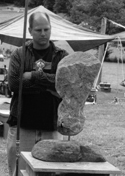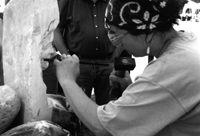Reflections of the "Ecstasy of St. Teresa" - Sept/Oct 2002
- Details
- Created: Monday, 02 September 2002 00:52
Alexandra Morosco's Artist Spotlight (July/August 2002) is a powerful, evocative, and revealing window into the life and work of a sculptor who has contributed significantly to NWSSA for many years in other ways. Now we see into the world of her sculpting, thanks to Larry Eickstaedt's interview. What I see there inspires me, energizes me, and infuses with me a sense of the importance of our work.
Alexandra's story of her afternoon meditations with Gianlorenzo Bernini's "The Ectasy of St. Teresa" in Rome reminded me of my own experience of that same sculpture about 15 years ago. I was fortunate to sell a sculpture from a travelling exhibition as it passed through Wenatchee, which funded a pilgrimage to Rome to see sculpture. At that time, Michelangelo was my main man in Italy, so the trip was full of wonderful surprises. A favorite discovery was the marble carving of Pope Pius IX in the Basilica of Santa Maria Maggiore, to which I returned several times. Once I went there to see how the sculptor had made the lace in the Pope's clothing (I could get as close as I wanted, so I could see detailed evidence of how the sculptor worked, and learn from it ).
My biggest discovery, however, was Bernini. I'd never heard of the man! I stumbled first upon "The Fountain of the Four Rivers" while walking through Piazza Navona, then noticed, but didn't really register, that the same sculptor made the "St. Longinus" in St. Peter's. But I was in for a shock at the Villa Borghese. To walk into that living room and confront the enormous and violent "Pluto Abducting Proserpina" would be a shock for anyone, I suppose (especially in a living room), but it totally stunned me as a work of art. But when I realized that Bernini carved "Apollo and Daphn"e (in the very next room) with a hammer and chisel, he became my hero and my quest.
The day I saw "The Ecstasy," my last day in Rome, I had spent until mid-afternoon in the vicinity of St. Peters, revisiting old discoveries and making new ones. I walked up and over the hill that stands back from the river, taking my time to study both the design and the construction of the Roman wall from the outside. When I entered Santa Maria della Vittoria, late in the afternoon on the other side of the hill, its stained glass windows glowed golden in the setting sun. But for a few candles burning here and there in chapels, though, it was dusky in the church. I found the Cornaro Chapel, but even as my eyes accommodated to the gloom, the gloom itself grew deeper, then deepened into darkness. I was too late to see "The Ecstasy!" Hoping against hope for a miracle, I stayed near the chapel, comforted by her presence and reflecting on my own ecstasy.
Then I heard a rustling. A nun dressed entirely in black walked quickly and surely toward me from a distant doorway, met my eyes briefly as she passed, then continued to the left end of the railing, reached under the rail, and "The Ecstasy of St. Teresa" EXPLODED into my view. Literally, in the same sense in which a flash flood arrives at a place, i.e., with no warning, she splashed light through my retinas and into my memory forever. It is such a powerful piece, and a powerful memory! Thanks, Alex, for the reminder.









